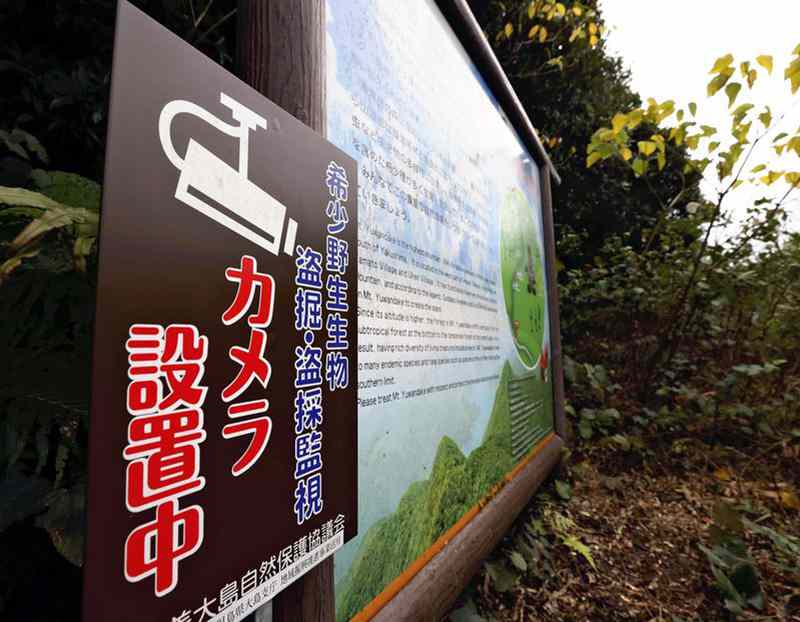
A sign reading “Security cameras are in place” is seen Dec. 17 on a mountain trail on Amami-Oshima island in Kagoshima Prefecture.
10:37 JST, January 10, 2022
Rampant poaching of rare plants and insects is taking place on Kagoshima Prefecture’s Amami-Oshima island, which was registered as a World Natural Heritage site in July.
Certain plants are in danger of extinction on Yakushima island in the same prefecture — Japan’s first World Natural Heritage site — due to past acts of illegal collection, and virgin forests have been damaged on the natural heritage Shirakami-Sanchi mountain range in Aomori and Akita prefectures, clearly illustrating the difficulty of protecting nature at these sites.
“There used to be a rare Liparis elliptica ground orchid here, but now…” said environmental protection volunteer Mamoru Tsuneda, his voice trailing off, pointing at a tree in a mountainous area of Amami-Oshima island where there were signs of a knife being used to cut away a ground orchid.
Countries submit nomination proposals for potential World Natural Heritage sites in their territory, and the United Nations Educational, Scientific and Cultural Organization (UNESCO) World Heritage Committee makes the final decision on designation. Currently, a total of 218 properties are registered as World Natural Heritage sites, including five in Japan.
The site titled “Amami-Oshima Island, Tokunoshima Island, Northern part of Okinawa Island, and Iriomote Island” has a subtropical climate, and the species on these islands evolved to form distinctive, abundant flora and fauna.
About 13% of all species in Japan are confirmed to exist on Amami-Oshima island, for which it was recognized as an important area to preserve biodiversity.
Taking plants is prohibited in many parts of the registered region. The Environment Ministry and relevant municipalities have strengthened patrols and baggage checks at airports. However, the illegal collection of plants has continued since July, and signs of digging in the ground with shovels have been found in the habitats of rare species, prompting suspicions of poaching.
The registered and surrounding areas are designated as a national park, and the natural park law prohibits setting traps in those areas without permission. According to the Kagoshima prefectural government, however, fruit put in stockings to lure insects with the scent was found in 14 locations on the island last fiscal year and in 11 locations this fiscal year.
Rare stag beetles are particularly popular, and those living only on the island are sold on internet auction sites for ¥3,000 to ¥10,000 each.
An official specializing in preserving rare species on remote islands at the Environment Ministry’s Amami Wildlife Center says that if a large number of specific insects are caught, the balance of species on the island will be destroyed.
Scars on beech trees
Yakushima island was registered as a World Natural Heritage site in 1993. The island was subsequently crowded with tourists who stepped on tree roots, weakening the trees, and wild mountain plants were illegally taken.
Local governments and others built walking paths and enhanced patrols. The trees are recovering, but the alpine plant Gentiana yakushimensis was designated as an endangered species in 2016, and the Geranium sikokianum in 2019, under the law for the conservation of endangered species of wild fauna and flora, due to sharp declines in their number.
In the Shirakami-Sanchi, virgin beech trees have been damaged almost every year, through such acts as engraving katakana characters in them with a knife.
Invasive species
On the Shiretoko Peninsula in Hokkaido, which was designated as a World Natural Heritage site in 2005, there were problems such as traffic jams and tourists approaching brown bears to take pictures.
In 2020, the Environment Ministry and others imposed restrictions on the use of private cars on the peninsula and started the trial use of shuttle buses to observe nature. In April last year, the revised natural park law was enacted, allowing authorities to impose a fine of up to ¥300,000 on those who continue to feed wild animals.
The Ogasawara Islands of Tokyo have been affected by invasive species. In 2013, two years after its registration as a World Natural Heritage site, the green anole lizard native to North America was found on Anijima island, where it had not been thought to exist. Since anole lizards eat insects, including rare ones, local residents are catching them.
The UNESCO World Heritage Committee and others are asking domestic World Natural Heritage sites to crack down on illegal poaching and take measures to deal with invasive species.
“Countries and municipalities that are home to World Heritage sites have a lot of responsibility to preserve their nature,” said Masahito Yoshida, a professor at the University of Tsukuba. “They need to make more efforts to address the issues facing them.”
"Society" POPULAR ARTICLE
-

M4.9 Earthquake Hits Tokyo, Neighboring Prefectures
-

M7.5 Earthquake Hits Northern Japan; Tsunami Waves Observed in Hokkaido, Aomori and Iwate Prefectures
-

Israeli Tourists Refused Accommodation at Hotel in Japan’s Nagano Pref., Prompting Protest by Israeli Embassy and Probe by Prefecture
-

Tsukiji Market Urges Tourists to Avoid Visiting in Year-End
-

M5.7 Earthquake Hits Japan’s Kumamoto Pref., Measuring Upper 5 Intensity, No Tsunami Expected
JN ACCESS RANKING
-

Keidanren Chairman Yoshinobu Tsutsui Visits Kashiwazaki-Kariwa Nuclear Power Plant; Inspects New Emergency Safety System
-

Imports of Rare Earths from China Facing Delays, May Be Caused by Deterioration of Japan-China Relations
-

University of Tokyo Professor Discusses Japanese Economic Security in Interview Ahead of Forum
-

Japan Pulls out of Vietnam Nuclear Project, Complicating Hanoi’s Power Plans
-

Govt Aims to Expand NISA Program Lineup, Abolish Age Restriction

















